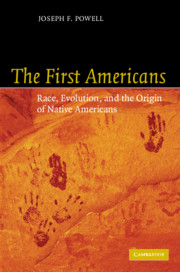Book contents
- Frontmatter
- Contents
- Acknowledgments
- Prologue: The Kennewick controversy
- PART I Race and variation
- PART II The Pleistocene peopling of the Americas
- PART III The First Americans, race and evolution
- 9 Racial models of Native American origins
- 10 Evolutionary models of Native American origins
- 11 The First Americans: Native American origins
- References
- Index
9 - Racial models of Native American origins
Published online by Cambridge University Press: 21 August 2009
- Frontmatter
- Contents
- Acknowledgments
- Prologue: The Kennewick controversy
- PART I Race and variation
- PART II The Pleistocene peopling of the Americas
- PART III The First Americans, race and evolution
- 9 Racial models of Native American origins
- 10 Evolutionary models of Native American origins
- 11 The First Americans: Native American origins
- References
- Index
Summary
It is easier to find Australoid-looking dolichocephals in the more ancient burials in the New World than anything in the way of a skull that resembles a Mongoloid.
E. A. Hooton, 1933I place all post hoc explanations of human biological variation such as population replacement by phenotypically different peoples, and colonization into the category of “typological assessments.” However, they can also be called model-free methods (Relethford and Lees, 1982), because they have no underlying hypotheses to test. Typological approaches to prehistoric human variation do not attempt to understand the dynamic processes underlying the observed phenotypic differences (or similarities) in populations, except as the product of historical events, that is, population migration/colonization (Neves et al., 1999b; Steele and Powell, 1992, 1993, 2002). The works of Blumenbach (1795), and Cuvier (1812) are by definition pre-evolutionary and thus racial–typological.
MIGRATION, COLONIZATION, AND THE FIRST AMERICANS
Late nineteenth- and early twentieth-century researchers (Gladwin, 1947; Hooton, 1930; Morton, 1839; Neumann, 1952; Rivet, 1943; Oetteking, 1934) and some recent authors continue to place the First Americans within a racial–typological framework, although some migration/racial–typological models have components that appear evolutionary (Chatters, 1998; Chatters et al., 1999; Greenberg et al., 1986; Neumann, 1952; Neves and Pucciarelli, 1989; Neves et al., 1996a, 1999a, 1999b, 2003; Steele and Powell, 1992, 1993; Turner, 1985a, 1990). These suggest some minimal role for microevolutionary processes, such as natural selection, genetic drift, and gene flow.
- Type
- Chapter
- Information
- The First AmericansRace, Evolution and the Origin of Native Americans, pp. 187 - 213Publisher: Cambridge University PressPrint publication year: 2005



